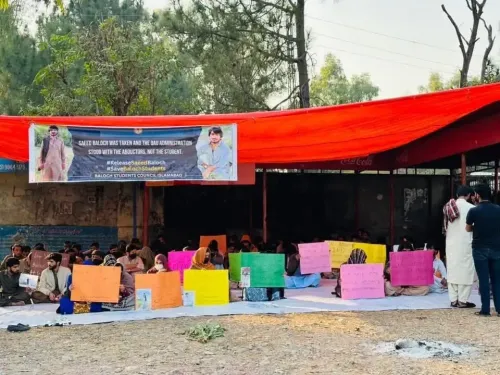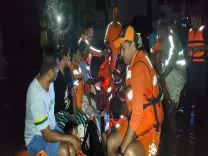Exploring the Historical Legacy of Hong Kong's Cheung Chau Island During Wartime

Hong Kong, Dec 15 (NationPress) On a chilly winter morning, 78-year-old Chen Kaixin was surrounded by tourists at the pier in Cheung Chau. "Look at how popular Cheung Chau is! Its other side should be known to more people," she stated.
Cheung Chau, a well-frequented tourist spot in Hong Kong, is renowned for its traditional Bun Festival. Just under an hour by ferry from the lively Central, this outlying island has a hidden narrative that remains largely uncovered, according to reports from Xinhua news agency.
Chen Kaixin is on a mission to reveal the untold history of her hometown Cheung Chau, which also holds significance as the battleground for her father, Chen Liangming.
Over 80 years ago, this dumbbell-shaped island, covering less than 3 square kilometers, was pivotal in a covert yet exhilarating operation.
At the close of 1941, Japanese forces invaded Hong Kong, placing hundreds of cultural figures and democrats seeking refuge in a precarious position.
Under the direction of the Southern Bureau of the Central Committee of the Communist Party of China, the predecessor to the East River Column, the Guangdong People's Anti-Japanese Guerrilla Force initiated a discreet rescue mission that spanned over 200 days. Ultimately, more than 800 individuals escaped Hong Kong under protection, many of whom later contributed significantly to the establishment of New China.
Throughout this operation, given the numerous land checkpoints and challenging conditions, some prominent figures, particularly those who were elderly and vulnerable, were arranged to leave by sea. Cheung Chau proved to be a vital transit location during this critical time.
Previously, a branch of the Communist Party of China had been established in Cheung Chau. At that period, the small island, home to only a few thousand residents, had around a dozen party members who often organized various initiatives.
"The Communist Party of China has been active here for many years, laying a strong organizational groundwork for the rescue operation," stated Wang Yuzhen, a descendant of an East River Column veteran and a researcher of Hong Kong's wartime history.
Chen Liangming, a native of Cheung Chau, was influenced by progressive ideologies during his studies in Shunde, a city in Guangdong Province. Upon his return, he joined the revolutionary movement and became a member of the Communist Party of China.
Thanks to the efforts of Chen Liangming and his peers, various local groups were mobilized to aid the extensive rescue operation, enabling dozens of cultural elites and democrats to successfully flee via Cheung Chau.
As the daughter of Chen Liangming, Chen Kaixin embodies a deeply rooted revolutionary spirit.
"The older generation is gradually passing away, and as their children, we are aging as well. However, the Hong Kong stories they have entrusted to us must endure," she emphasized. "This is a rescue mission, and time is of the essence!"
Chen and her sisters, alongside Wang and several descendants of Hong Kong wartime veterans, reached out to various organizations and formed a team of over a dozen individuals. They aimed to merge first-hand accounts from the elderly and unearth a more comprehensive historical narrative.
A book published in 1999 by the People's Liberation Army Press about the rescue operation referenced two landing sites in Cheung Chau: a joss stick factory and a fish market, corroborated by multiple sources.
In April of this year, with the assistance of members from the Islands District Council and the Cheung Chau Rural Committee, they visited several elderly individuals familiar with the events.
"We warmly welcome their arrival," stated Ng Man-kit, chairman of the Cheung Chau Rural Committee, adding that the people of Cheung Chau should learn about the contributions made by their ancestors in the country's rescue efforts and take pride in their heritage.
While gathering oral histories, team members consulted the Hong Kong Public Records Building and the Lands Department of the Hong Kong Special Administrative Region government multiple times, examining mapping data and historical photographs of Cheung Chau. They also conducted extensive searches through online databases both domestically and internationally.
Lai Sze Nga, the youngest member of the team and a granddaughter of an East River Column veteran, handled most of the online research.
"My grandfather is no longer with us, and this is my way of honoring his memory. Searching for information makes me feel a little closer to him," Lai expressed.
"I also wish for more young people to recognize these stories and understand that Hong Kong people have always had a tradition of patriotism and love for their city," she underscored.
After months of relentless effort, the team compiled a comprehensive report, initially identifying the historic sites of the joss stick factory and fish market and reconnecting with the descendants of two families.
Additionally, they identified other revolutionary landmarks on the island, including a school that is now the Cheung Chau Government Secondary School, which served as temporary barracks for soldiers following the victory in the War of Resistance against Japanese Aggression.
This report has garnered significant attention from various sectors in Hong Kong. The Hong Kong Chronicles Institute's research team is planning publications based on this material, while the New Territories Association of Societies aims to establish memorial facilities dedicated to revolutionary history in the outlying islands.
Recently, Chen has frequently returned to her hometown to coordinate follow-up efforts with various parties. Like many, she aspires for the wartime legacy of her predecessors to be recognized by a broader audience.









